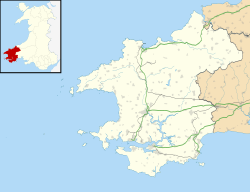| Penycwm | |
|---|---|
 Penycwm and A487 road | |
Location within Pembrokeshire | |
| OS grid reference | SM849234 |
| Community | |
| Principal area | |
| Country | Wales |
| Sovereign state | United Kingdom |
| Police | Dyfed-Powys |
| Fire | Mid and West Wales |
| Ambulance | Welsh |
Penycwm (Welsh for "Head of the valley") is a small settlement on the A487 road near Newgale, Pembrokeshire, Wales. It is part of the community (formerly civil parish) of Brawdy. At the other end of a valley to the coast is Penycwm beach, also known as Pwll March. [1] Penycwm is close to the popular Newgale Sands, on the Pembrokeshire Coast Path and in the Pembrokeshire Coast National Park. [2]
The village's Independent Chapel, built in Gothic style in stone in 1870, had become a private residence by 2004. [3]
To the northeast is Llethr, an 18th and 19th house, owned by the Thomas family until 1823, but in a poor state of repair when inspected in 1993. The house is a Grade II listed building, as is the house's stable block. [4] [5] Penycwm was the location for the United Kingdom's first 5-star youth hostel. [6]
